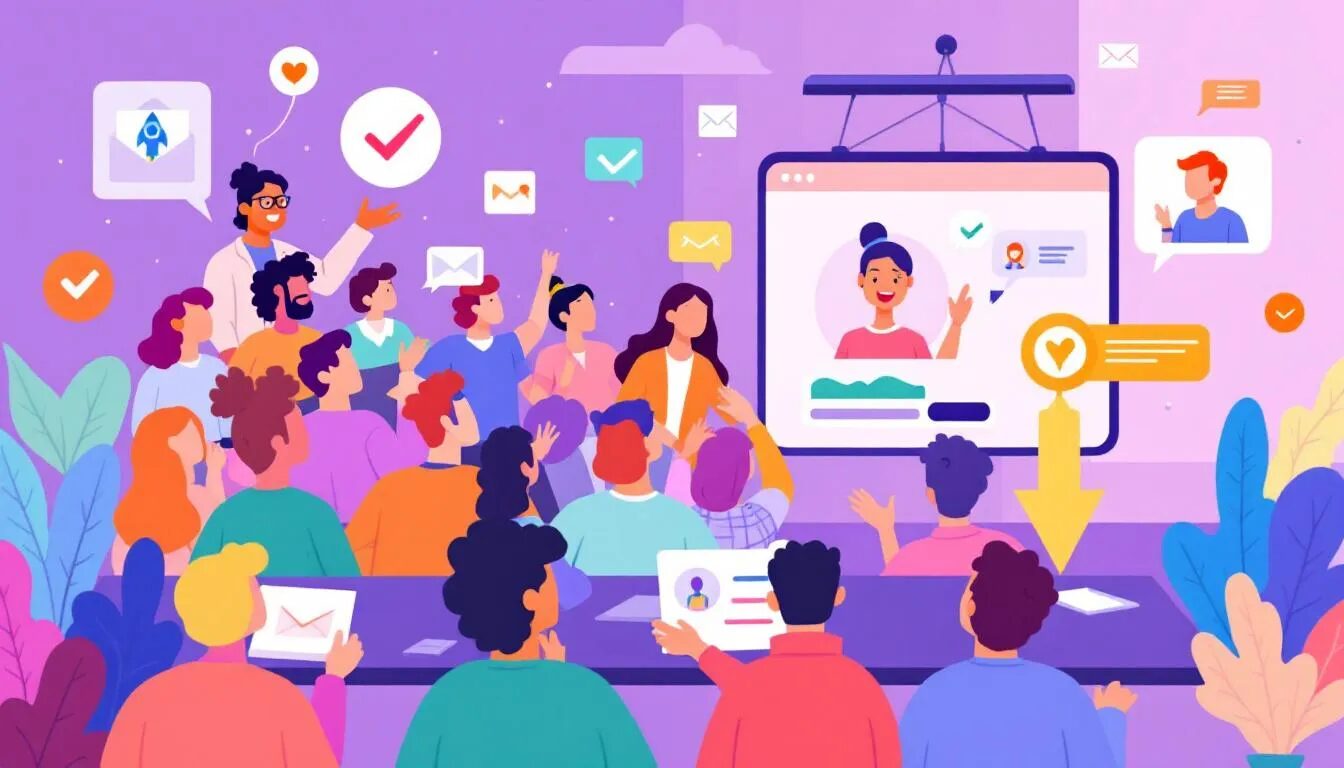
What We Learned From Analyzing 1 Million Emails Sent by Small Businesses: Top Insights and Strategies
Our analysis of 1 million emails sent by small businesses reveals crucial tactics for enhancing email marketing, specifically what we learned from analyzing 1 million emails sent by small businesses. This post shares the most important lessons and lessons learned from sending and analyzing a million emails.
In this post, we’ll cover lessons learned sending a large volume of emails, including what’s working best—from personalization techniques to optimal send times—and how to apply these findings to boost your campaign results.
Key Takeaways
- Personalization significantly boosts email open and click-through rates, enhancing customer engagement.
- Optimal send times for emails vary between B2B and B2C audiences, with specific times during weekdays yielding the best engagement.
- Audience segmentation and A/B testing are essential strategies for improving email marketing performance and effectiveness.
The Importance of Personalization
Personalization in email marketing isn’t just a buzzword; it’s a game-changer. Personalized messages can lead to an astounding increase in open rates by over 20% compared to generic emails. Why does this happen? It’s simple—people love feeling special. When an email addresses them by name or references their past behavior, it creates a sense of connection and relevance.
Moreover, emails that are personalized see a significant boost in click-through rates, with some reports showing a 139% rise. This isn’t surprising when you consider that personalized emails are 26% more likely to be opened than their non-personalized counterparts. Tailoring your messages captures attention and builds stronger customer relationships.
Including additional information such as the recipient’s job title, company name, or alma mater in personalized emails makes the message more human and can further increase engagement.
Additionally, personalization goes beyond just using a recipient’s name. Incorporating relevant content and employing personalization tokens can enhance engagement and reduce spam complaints. Personalized strategies in email campaigns lead to better engagement and overall marketing success. So, take a page from Justin Michael and invest time personalizing your emails for higher engagement.
Optimal Send Times for Higher Engagement
Timing is everything, especially in email marketing. Optimizing send time is a crucial part of any email marketing strategy, as choosing the right send time can significantly improve open and response rates. Our analysis shows that engagement levels tend to be higher when emails are sent during weekdays, particularly from 10 AM to 2 PM. For B2B marketing, the sweet spot is between Tuesday and Thursday during working hours. Sending emails during lunch breaks, around 12 PM to 1 PM, can also increase engagement among professionals.
On the other hand, B2C emails often see better engagement in the evenings and on weekends. Retailers may find Thursday evenings particularly effective for their business, aligning with customers’ pre-weekend planning. Considering the recipient’s time zone can maximize engagement.
Regularly scheduled emails help create anticipation among readers, making them part of their daily routine. Incorporating these insights into your email marketing strategy ensures that your messages are delivered at the right time, leading to higher open rates and better response rates. Understanding optimal send times makes your email campaigns more effective for engagement and conversions. Additionally, you can send emails that align with these strategies for even greater impact.
Effective Subject Lines for Small Businesses
The subject line is the first impression your email makes, and it can make or break your campaign. Here are some tips for effective subject lines:
- Keep the character count to 50 or less to better capture attention.
- Use humor or a playful tone to enhance engagement and improve open rates.
- Note employing witty and unorthodox approaches, such as using celebrity lyrics, to make your subject lines stand out.
Questions in subject lines can pique curiosity and encourage recipients to open the email. Including numbers or lists suggests concise content and attracts attention. Furthermore, aligning subject lines with the recipient’s interests or recent activities can enhance relevance and engagement, leading to better responses and more details, which ultimately leads to improved communication.
Personalization in subject lines, such as including the reader’s first name, can increase the open rate by 9%. Compelling and relevant subject lines significantly improve email marketing success and capture potential customers’ interest.
Segmenting Your Audience for Better Results
Audience segmentation is a cornerstone of effective email marketing. Segmenting your audience allows for tailored messages to specific groups, enhancing communication and relevance. Providing relevant content through segmentation improves the customer experience at different stages of their journey. This personalized approach ensures that your messages resonate with subscribers, leading to higher engagement.
There are various ways to segment your audience, including demographics and interests. Behavioral segmentation, which tailors campaigns based on subscriber engagement patterns, is particularly effective. Using personalized preview text based on subscriber interests can significantly increase engagement.
Overall, effective segmentation strategies lead to improved campaign performance and better engagement rates. Understanding and implementing audience segmentation enhances email marketing strategies and achieves better results.
The Power of A/B Testing
A/B testing is a powerful tool for optimizing email campaigns. It allows businesses to discover what resonates best with their audience by testing variations of:
- Subject lines
- Email content
- Preview text Testing different elements can significantly enhance engagement rates. For instance, testing variations of preview text helps identify what resonates best with the target audience.
Key recommendations for running tests include:
- Running tests for at least 1-2 weeks to gather comprehensive data across varied audience behaviors.
- Achieving a statistical confidence of at least 95% to validate test results and implement changes.
- Testing a single element at a time to pinpoint the specific cause of performance changes.
Leveraging A/B testing helps continuously improve email campaigns, enhance engagement, and drive better results.
Building Trust Through Consistent Messaging
Consistent messaging is crucial for building trust with your audience. It reinforces brand identity by establishing familiarity with the email’s tone and style over time. When subscribers know what to expect from your emails, they are more likely to engage with them.
Maintaining high-quality content in your emails is essential for building trust amidst a crowded inbox. Delivering a large amount of valuable and consistent messages creates a loyal subscriber base that looks forward to your emails.
Leveraging Data for Continuous Improvement
Data shows that the backbone of successful email marketing is monitoring key metrics, including:
- Open Rate
- Click Rate
- Bounce Rate
- Unsubscribe Rate
- Spam Complaint Rate
- Response rate
- Click rates
Ensuring benchmarks for these metrics and conversion rates are met should be a top priority for email marketing campaigns. Detailed documentation of tests and results helps identify trends and prevent repeated mistakes.
Real-time dashboards that track performance metrics can lead to immediate adjustments in email strategies based on observed changes at this point. Time-based engagement analysis helps understand subscriber interaction with content beyond just clicks, indicating deeper engagement levels.
Effective segmentation can lead to increased ROI by ensuring that marketing messages resonate with the intended audience. Leveraging data enables continuous improvement in email marketing strategies and helps achieve predictable revenue.
Companies can leverage their site to deliver targeted offers and drive conversions based on email engagement data. Additionally, companies are increasingly using mobile channels and platforms to engage customers and run parts of their sales and communication processes.
Crafting Compelling Preview Text
Preview text plays a crucial role in email marketing. Key points include:
- About 24% of email recipients consider the preview text before deciding to open an email.
- Utilizing custom preview text can boost open rates by more than 30%.
- Concise preview text, ideally under 50 characters, ensures visibility on most email clients and devices.
Including links in preview text or images can make emails more interactive and improve click-through rates.
Effective preview text highlights the value of the email content, making it clear to recipients why opening the email is beneficial. For example, it should create curiosity by hinting at the content without fully disclosing it, enticing readers to click the link.
Compelling preview text can improve email open rates and engagement.
Avoiding Common Pitfalls in Email Marketing
Email marketing is not without its challenges:
- Frequent emails can overwhelm subscribers, leading to unsubscribes.
- It’s important to provide valuable insights rather than constantly pushing discounts, which can train subscribers to wait for offers.
- Failing to send a welcome email misses an opportunity to engage new subscribers.
Concise emails that provide value are preferred over lengthy communications. Removing repetitive sentences and those that don’t offer value ensures that your messages are effective. The majority of communication with subscribers should focus on providing valuable insights and words rather than promotions from the company.
How you write your emails—focusing on clarity and value—can help avoid common pitfalls and improve engagement.
Avoiding these common pitfalls enhances email marketing strategies and achieves better results.
Enhancing Deliverability and Reducing Spam Complaints
Deliverability is a critical aspect of email marketing. Key points to consider include:
- Sender reputation is influenced by email engagement metrics like opens and clicks.
- A Welcome Series can boost deliverability and sender reputation by engaging new subscribers effectively.
- Constant monitoring of deliverability and metrics like spam complaints is crucial for maintaining a good email reputation.
Segmentation improves sender reputation, as targeted emails lead to higher engagement and lower chances of being marked as spam. Regularly cleaning your contact list by removing outdated or unengaged emails can improve deliverability. Implementing a double opt-in process helps ensure that new subscribers are genuinely interested, reducing spam complaints.
Focusing on these strategies enhances deliverability and reduces spam complaints, ensuring emails deliver to recipients’ inboxes through an effective channel and our services. A dedicated team working together can ensure best practices are consistently followed for optimal deliverability and minimizing spam complaints.
Summary
Throughout our analysis of one million emails sent by small businesses, we’ve uncovered key insights and strategies that can transform your email marketing efforts. From the importance of personalization and optimal send times to effective subject lines and audience segmentation, these strategies can lead to higher engagement and better results.
By implementing these insights, small businesses can build trust, optimize their campaigns, and continuously improve their email marketing strategies. Remember, the key to success lies in understanding your audience, providing valuable content, and leveraging data to make informed decisions. Additionally, applying these email marketing strategies can support broader strategic sales goals, helping small businesses align their marketing efforts with long-term sales growth and high-level planning.
Frequently Asked Questions
What is the most misunderstood aspect of business emails?
The most misunderstood aspect of business emails is the lack of tone and emotional cues, which can lead to misinterpretation. It’s essential to be mindful of how your message might be perceived without non-verbal signals.
Why is email marketing important for small businesses?
Email marketing is crucial for small businesses as it enables cost-effective communication, fosters strong customer relationships, and drives repeat purchases, all while providing measurable results. This makes it a valuable tool for expanding customer bases and enhancing long-term loyalty.
How do you analyze the effectiveness of your email communication?
To effectively analyze your email communication, focus on key metrics such as bounce rate, website traffic, conversion rate, email list growth rate, and the forward/share rate. These indicators will provide a comprehensive view of your email’s impact and engagement.
Why is personalization important in email marketing?
Personalization is crucial in email marketing because it enhances open and click-through rates, fostering stronger customer relationships and increasing overall engagement. It makes your communications more relevant to each recipient, ultimately driving better results.
When is the best time to send emails for higher engagement?
The best time to send emails for higher engagement is on weekdays from 10 AM to 2 PM for B2B audiences, while B2C emails perform better in the evenings and on weekends.
© 2025, Vertical Response. All rights reserved.



